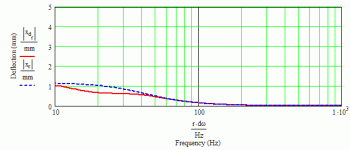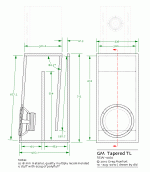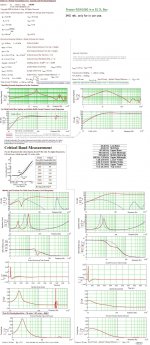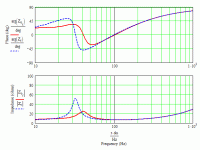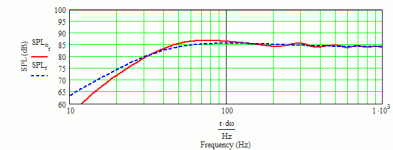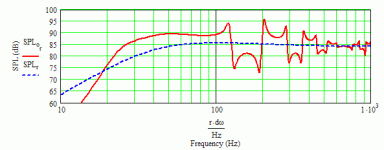only for if you have DSP
In the book Toole shows what they found with just regular subs, Then with the addition of DSP hoe much better you could do (only really needed for the time delay, level and parametric EQ can be done in the analog domain)
dave
The amount of holes and the diameter doesn't really matter?
I don't understand this emulating sticking them in the wall with the back hanging outside the house without actually doing that. Could you explain to me? I'm curious and this aperiodic thing is new to me. Anywhere i could read about it and how it works?
I wont let him disencourage me. I've read about ppl buying these drivers. And that guy on the swedish forum is very happy with the 4 he finished and he has been using various SVS-stuff and CSS SDX-subs.
I don't understand this emulating sticking them in the wall with the back hanging outside the house without actually doing that. Could you explain to me? I'm curious and this aperiodic thing is new to me. Anywhere i could read about it and how it works?
I wont let him disencourage me. I've read about ppl buying these drivers. And that guy on the swedish forum is very happy with the 4 he finished and he has been using various SVS-stuff and CSS SDX-subs.
I wont let him disencourage me. I've read about ppl buying these drivers.
And that guy on the swedish forum is very happy with the 4 he finished
and he has been using various SVS-stuff and CSS SDX-subs.
Hi,
I'm not trying to discourage you, only tell you you have made things more
difficult for yourself, and getting them to work well is going to be complicated.
Using boxes any bigger than 2xVas (well stuffed effective volume) will be
near pointless, and with very carefully arranged aperoidic loading you
should get good results, but it it not be "will that do", you will have to
get it right for it to work well.
I do not know enough about TL's to discuss that alternative option.
Other alternatives are a Linkwitz Tranforms or the "Ace Bass" principle.
None of the alternatives are as simple as sealed or vented boxes.
😎 /Sreten.
Last edited:
Very tall? Well, i don't mind if i could place my Mar-Kel70's on them at a reasonable height.
It's 80" long, so folding it in half will make it a bit tall for a stand and in fourths maybe a bit too low, but thirds puts either the driver or terminus up off the floor too much for max boundary loading.
Anyway, it's a reverse tapered TQWT with a 75"^2 closed end and 15"^2 at the terminus with a 15"^2 baffle thickness vent. The sim uses a 0.75 lb./ft^3 polyfil stuffing density. Dashed trace is an infinite baffle response (>3900 L), so not too shabby for only ~54 L plus its excursion is better damped.
GM
Attachments
It's 80" long, so folding it in half will make it a bit tall for a stand and in fourths maybe a bit too low, but thirds puts either the driver or terminus up off the floor too much for max boundary loading.
Anyway, it's a reverse tapered TQWT with a 75"^2 closed end and 15"^2 at the terminus with a 15"^2 baffle thickness vent. The sim uses a 0.75 lb./ft^3 polyfil stuffing density. Dashed trace is an infinite baffle response (>3900 L), so not too shabby for only ~54 L plus its excursion is better damped.
GM
Agree, A TQWT is a better solution than this would be:
b
 🙂
🙂Attachments
Is it okay to build subwoofers in MDF? Building such large ones in
birchply seems a little overkill for a driver that costs around 40$ each.
And then spend 150$ of materials for each box makes no sense.
I'd rather spend like 50-60 if possible.
Hi,
As no-one else has I'll answer this. For the cost, the difference in sonic
signatures of MDF and high quality ply is only worth it IMO for wide range
cabinets and for that only worth it for the higher quality drivers IMO.
(Of course if driver upgrades are possible this may need rethinking.)
For your TL subs (and most subs) using MDF will be fine.
😎 /Sreten.
It's 80" long, so folding it in half will make it a bit tall for a stand and in fourths maybe a bit too low, but thirds puts either the driver or terminus up off the floor too much for max boundary loading.
Anyway, it's a reverse tapered TQWT with a 75"^2 closed end and 15"^2 at the terminus with a 15"^2 baffle thickness vent. The sim uses a 0.75 lb./ft^3 polyfil stuffing density. Dashed trace is an infinite baffle response (>3900 L), so not too shabby for only ~54 L plus its excursion is better damped.
GM
Hi GM,
A quick question if you not mind .....
What would be the effect of moving the driver from the bottom of
the baffle to the top, that would be near say 1/4 length positioning.
(Related to P10's 3 fold cabinet drawing)
The reason I ask is avoiding max boundary loading is the fundamental
principle of smoothing the excitation of the main room modes, though
you need to cross the subs over low enough to avoid the floor dip.
Rgds, Sreten.
How does this look?
Do you have an impedance plot?
At a glance it looks fine, though as I implied I'm all about getting as much acoustic gain as practical to increase tuning flexibility, so the terminus ideally needs to be at floor level also. WRT any discontinuity in the bending, within reason, its stuffing density is adequate to smooth it out.
To make it ~aperiodic, i.e. ~completely damp its impedance peak/flatten its phase response will require shortening its path-length while ~maintaining its net Vb.
GM
Attachments
For the cost, the difference in sonic
signatures of MDF and high quality ply is only worth it IMO for wide range
cabinets and for that only worth it for the higher quality drivers IMO.
(Of course if driver upgrades are possible this may need rethinking.)
For your TL subs (and most subs) using MDF will be fine.
😎 /Sreten.
Never have nor never will agree with all this as presented for the reasons me and others have posted on the various threads devoted to the subject, so the OP can Google the subject if he wants to delve into the design/construction of high performance speaker cabs.
WRT to this specific driver though, I agree with your material choice since it has a Qts > 0.5, so using a somewhat under-damped construction helps to dynamically lower its high Q 'ringing', especially since it's probably higher than published and since a folded cab is already pretty well braced I doubt it will need more except possibly a motor support/brace to mass load it to the cab.
GM
GM. Do you say that MDF is a good choice?
And what about this mass-loading? Isn't it the same with my Mar-Kel70's?
And what about this mass-loading? Isn't it the same with my Mar-Kel70's?
Never have nor never will agree with all this as presented for the reasons me and others have posted on the various threads devoted to the subject, so the OP can Google the subject if he wants to delve into the design/construction of high performance speaker cabs.
WRT to this specific driver though, I agree with your material choice since it has a Qts > 0.5, so using a somewhat under-damped construction helps to dynamically lower its high Q 'ringing', especially since it's probably higher than published and since a folded cab is already pretty well braced I doubt it will need more except possibly a motor support/brace to mass load it to the cab.
GM
Hi,
Well it seems a very contentious issue and different viewpoints abound.
😎 /Sreten.
Hi GM,
A quick question if you not mind .....
Greets!
Moving the driver down the length of any taper (straight, positive or negative expanding) TL reduces its fundamental + harmonics loading and introduces a second set that comb filters with them, shifting its F3 up/down based on the taper and stuffing density and shifting its harmonic structure higher up where it takes less damping to quell them. In short then, when the right offset is found you'll get the best trade-off between damping, widest ~flat BW. Refer to MJK's excellent Classic TL alignment doc for what the math told him.
My way is a bit different since it's more intuitive/experience than math derived, but don't look all that much different in a sim, so would have to A-B several different pairs to see if they are audibly different and/or which sounds more life-like.
My SWAG though is that floor bounce and the eigenmode between the driver and any near boundaries is more important than hitting a theoretically ideal point along a TL's path-length, so at minimum I'd want the speaker setting on a very absorptive pad and angled > ~9.46° (1" in 6" slope) to diffuse any reflections (AKA 'slap echo') somewhat. Angling all the speakers sides back > ~9.46° then also negates the need for the pad.
Regardless, for this particular alignment the offset doesn't appear to be audibly different since it doesn't have a particularly high taper.
If the OP's budget wasn't a major issue I would have recommended using this TQWT with only just enough wall lining to keep it from sounding hollow since it's for 'sub' duty, but then he would need a high order digital XO to roll it off enough to make its HF 'hash' 'disappear'.
GM
Attachments
Hi GM. Thanks for the reply, rgds, /Sreten.
P.S. I think I agree more with you about MDF and Ply than I disagree,
I think the subjective issue is where do you want to draw the line.
P.S. I think I agree more with you about MDF and Ply than I disagree,
I think the subjective issue is where do you want to draw the line.
GM. Do you say that MDF is a good choice?
And what about this mass-loading? Isn't it the same with my Mar-Kel70's?
All things considered for this particular driver/alignment, an acceptable one anyway. A structural and/or mechanical engineer could probably find a better/'best' choice and/or just the ideal thickness for MDF once what you bought had all its pertinent material properties measured (world-wide or even country wide, MDF specs historically haven't been very uniform), but way too math/time intensive for most folks. Indeed one could make it out of anything from cardboard to sheet metal and make it perform well since it's just a matter of empirically finding a good enough amount of material thickness, bracing and damping if time isn't a factor.
Right, the vertical brace, which ideally needs to add a very slight pressure against the driver once secured in place.
GM
Hi GM. Thanks for the reply, rgds, /Sreten.
P.S. I think I agree more with you about MDF and Ply than I disagree,
I think the subjective issue is where do you want to draw the line.
You're welcome!
Frankly, considering the body of knowledge available learned from building all manner of buildings, bridges, cars, planes, explosion proof containers, sonic boom generators, etc., I don't see how there's any room for dispute.
GM
At a glance it looks fine, though as I implied I'm all about getting as much acoustic gain as practical to increase tuning flexibility, so the terminus ideally needs to be at floor level also.
Having seen a picture of where they are likely to be placed the terminus will be very close to the wall.
dave
So... The best enclosure is a TL?
And having them close to wall is not a problem at all. It's just very good actually.
And having them close to wall is not a problem at all. It's just very good actually.
I think it the best of the options provided so far...
dave
Hi,
Cannot argue with that, especially in 54L,
I thought a TL would be bigger,
😎 /Sreten.
- Status
- Not open for further replies.
- Home
- Loudspeakers
- Subwoofers
- What enclosure for those subs?

